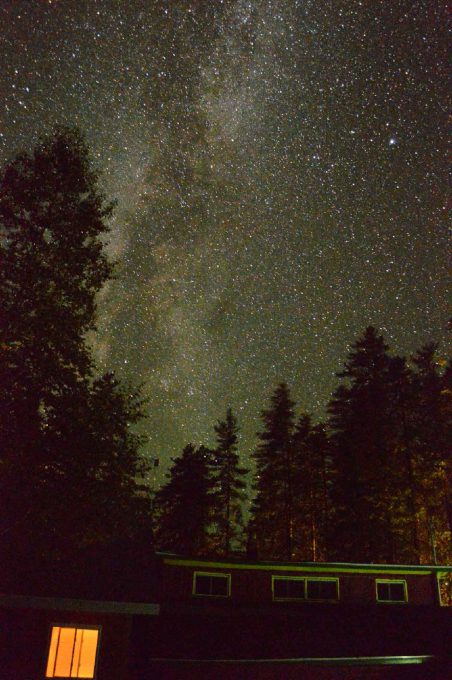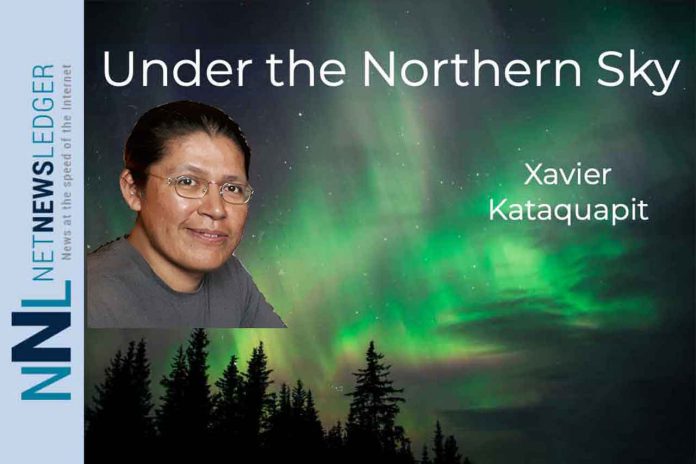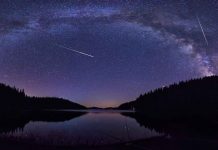Last week, I had an opportunity while visiting a northern cottage to sit outside and contemplate the night time sky. Normally, in the summer this is almost always impossible as either the weather is not favourable, the bugs are too numerous or a full or partial moon throws too much light to see many stars clearly. On this night, all the conditions were perfect as there was no moon, the sky was completely clear of weather and the biting insects somehow had miraculously disappeared.

The Milky Way over the camp.
I put out a lounge chair and reclined until I was completely lying flat and I stared out into the heavens to view the endless expanse of shimmering stars. Although I only had a pair of binoculars to help me get a better look at the stars this helped me to get lost in even more of the infinite view. At this time of the year in North America, the Milky Way Galaxy appears as a wide dim stream of dark and pale cloudy light across the sky. Here in the night sky, with little light pollution, I could easily view the majestic Milky Way. True to its name I felt as though I was staring into a vast ocean of darkness and sparkles with a huge whirl of wispy faint white light.
My father Marius taught us that the stars on clear nights were a way to help travelers move across the land. He didn’t teach me any constellations but he showed me and my brothers how the formation of what is known as the Big Dipper provides a way of pointing to the north. He always reminded me that no matter the season, this formation of stars would always help me find my way home.
While growing up in the north in my home community of Attawapiskat on the James Bay coast, my brothers, cousins, and friends and I had many opportunities to view the night time sky. There is little light pollution up the coast and I recall many times when we headed out on the land we were swallowed up in the darkness as we moved from one place to another. In the chaos and dysfunction of growing up in the community, the eerily darkness of the night and the light of so many stars helped us to forget about our worries and caused us to wonder about the wider world above our heads.
On the land at my cottage, those days back on the coast came back to me. Once again the starry night sky came to comfort me. I forgot about the current world crisis happening right now. The idea of seeing so many distant points of light made my mind wander away from the worries of the world, the dread of a pandemic, and the never-ending stream of depressing news headlines filling our televisions, computers, tablets, and smartphones.
I did some astrophotography with the bit of camera equipment I had on hand. My set up, although not sophisticated, was enough for me to capture some long exposure images of the galaxy overhead. On one of my images, I was happy to discover that I could see the faint outline of the Andromeda Galaxy, the nearest galaxy to our own at 2.5 million light-years away. I could also see it as a dim hazy almond-shaped cloud through my binoculars. I am always amazed at this image in the sky because it means I am looking at light that had left that galaxy two and a half million years ago. There is nothing like staring at the heavens to remind one of how insignificant we are as humans.
I suggest that if you have a moment in your evening once the sun has gone down, step away from your devices for a moment or two and go outside when the sky is clear or even partially clear. Find a spot to sit down or even lie down away from any artificial light nearby. Take a moment to adjust your vision to the dark and find the milky band of cloudy light that is actually the illumination of billions of stars within our own galaxy. Even if you don’t know your constellations, important stars, or the location of galaxies, clusters, nebula, or other objects, just realize that every point of light you are viewing is often tens, hundreds, and even thousands of light-years away. It means it took the light of those distant points of light tens, hundreds, or thousands of years to reach us.
I really believe that troubled times and worried minds seem to fade away when we take the opportunity to look up and connect to a greater reality and the wonder of it all.
www.underthenorthernsky.com





